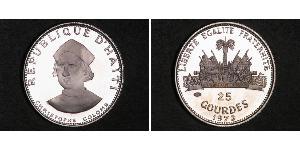25 Gourde (Vendida por $8.0)
1973, Haiti. Proof-like Silver 25 Gourdes "Christopher Columbus" Coin.
Mint Year: 1973 Mintage: 8,685 pcs. References: KM-102. Denominations: 25 Gourdes Condition: Uneven toning, otherwise a nice proof-like uncirculated! Material: Sterling Silver (.925) Diameter: 30mm Weight: 9.94gm
Obverse: Facing bust of Christopher Columbus 3/4 left. Legend: REPUBLIQUE D'HAITI / CHRISTOPHE COLOMB Reverse: Arms of the Republic of Haiti. Value and date below. Purity marking (925) on raised oval disc in left field. Legend: LIBERTE EGALITE FRATERNITE / 25 GOURDES 1973
Haiti, officially the Republic of Haiti, is a Caribbean country. It occupies the western, smaller portion of the island of Hispaniola, in the Greater Antillean archipelago, which it shares with the Dominican Republic. Ayiti (land of high mountains) was the indigenous TaÃno or Amerindian name for the island. The country's highest point is Pic la Selle, at 2,680 metres (8,793 ft). The total area of Haiti is 27,750 square kilometres (10,714 sq mi) and its capital is Port-au-Prince. Haitian Creole and French are the official languages.
Navigator Christopher Columbus landed at Môle Saint-Nicolas on 5 December 1492, and claimed the island for Spain. Nineteen days later, his ship the Santa María ran aground near the present site of Cap-Haïtien. Columbus left 39 men on the island, who founded the settlement of La Navidad.
The sailors carried endemic Eurasian infectious diseases. The natives lacked immunity to these new diseases, and died in great numbers in epidemics. The first recorded smallpox outbreak in the Americas occurred on Hispaniola in 1507. The encomienda system forced natives to work in gold mines and plantations.
The Spanish passed the Laws of Burgos, 1512–1513, which forbade the maltreatment of natives, endorsed their conversion to Catholicism, and gave legal framework to encomiendas. The natives were brought to these sites to work in specific plantations or industries.
As a gateway to the Caribbean, Hispaniola became a haven for pirates during the early colonial period. The western part of the island was settled by French buccaneers. Among them was Bertrand d'Ogeron, who succeeded in growing tobacco. He attracted many French colonial families from Martinique and Guadeloupe. European nations were competing for control in the New World, in the Caribbean as well as in North America. France and Spain settled their hostilities on the island by the Treaty of Ryswick of 1697, and divided Hispaniola between them.
France received the western third and subsequently named it Saint-Domingue. To develop it into sugar cane plantations, they imported thousands of slaves from Africa. Sugar was a lucrative commodity crop throughout the eighteenth century. By 1789, approximately 40,000 French colonists lived in Saint-Domingue. In contrast, by 1763 the French population of Canada, a much larger territory, had numbered 65,000. The French were vastly outnumbered by the tens of thousands of African slaves they had imported for decades to work on their plantations, which were primarily devoted to the production of sugar cane. Particularly in the north, slaves retained many ties to African cultures, religion and language, as they were continually renewed by new imports. they outnumbered whites by about ten to one.
The French-enacted Code Noir ("Black Code"), prepared by Jean-Baptiste Colbert and ratified by Louis XIV, had established rules on slave treatment and permissible freedoms. Saint-Domingue has been described as one of the most brutally efficient slave colonies; one-third of newly imported Africans died within a few years. Many slaves died quickly from tropical diseases, smallpox, and typhoid fever. They had low birthrates, and there is evidence that some women aborted fetuses rather than give birth to them in slavery.
As in its Louisiana colony, French colonists provided some rights to free people of color, the mixed-race descendants of female slaves (and later mixed-race women) and white colonists. Over time, many were given freedom. They established a separate class. White French Creole fathers frequently sent their mixed-race sons to France for education. Some were admitted to the military. More of the free people of color lived in the south of the island, near Port-au-Prince, and many intermarried within their community. They frequently worked as artisans and tradesmen, and began to own some property. Some became slaveholders. They petitioned the colonial government to expand their rights.
Only 1$ shipping for each additional coin purchased!





 English
English












